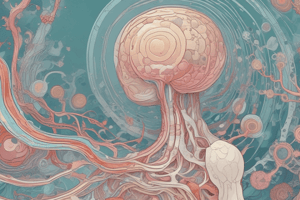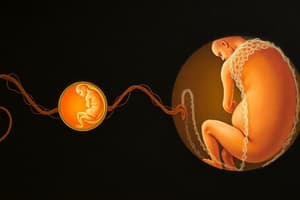Podcast
Questions and Answers
What is the primary enzyme in sperm that facilitates penetration of the zona pellucida during fertilization?
What is the primary enzyme in sperm that facilitates penetration of the zona pellucida during fertilization?
- Hyaluronidase
- Trypsin
- Collagenase
- Acrosin (correct)
Where in the female reproductive system does fertilization primarily take place?
Where in the female reproductive system does fertilization primarily take place?
- Uterine cavity
- Cervix
- Ampulla of the fallopian tube (correct)
- Ovary
Which mechanism occurs to prevent multiple sperm from fertilizing the same oocyte?
Which mechanism occurs to prevent multiple sperm from fertilizing the same oocyte?
- Completion of the second meiotic division
- Activation of phospholipase C
- Cortical reaction (correct)
- Repolarization of the membrane
What term describes the rapid mitotic divisions that occur in the zygote after fertilization?
What term describes the rapid mitotic divisions that occur in the zygote after fertilization?
At what point post-fertilization does the blastocyst typically implant into the uterine wall?
At what point post-fertilization does the blastocyst typically implant into the uterine wall?
Which hormone produced by trophoblast cells is key for pregnancy confirmation?
Which hormone produced by trophoblast cells is key for pregnancy confirmation?
Which embryonic structure contributes to the formation of the placenta?
Which embryonic structure contributes to the formation of the placenta?
How is the morula characterized after several cell divisions of the zygote?
How is the morula characterized after several cell divisions of the zygote?
What process is responsible for the removal of the zona pellucida to allow implantation?
What process is responsible for the removal of the zona pellucida to allow implantation?
Which cell type in the blastocyst is responsible for developing into the embryo proper?
Which cell type in the blastocyst is responsible for developing into the embryo proper?
Flashcards are hidden until you start studying
Study Notes
Fertilization
- Acrosin, an enzyme present in the sperm head, is responsible for breaking down the zona pellucida, a protective layer surrounding the oocyte.
- Fertilization typically occurs in the ampulla of the fallopian tube.
- Cortical reaction is a process that prevents polyspermy (multiple sperm fertilizing an egg). It involves the release of enzymes from cortical granules that harden the zona pellucida, preventing further sperm entry.
Development after Fertilization
- After fertilization, the zygote undergoes rapid mitotic divisions called cleavage, resulting in a solid ball of cells called a morula.
- The morula further develops into a blastocyst, a hollow ball of cells with an inner cell mass (ICM) and an outer layer called the trophoblast.
- The blastocyst implants into the uterine wall around 6-7 days after fertilization.
- The trophoblast differentiates into the syncytiotrophoblast, which invades the maternal endometrium during implantation.
Roles of Hormones in Early Pregnancy
- Human chorionic gonadotropin (hCG) is produced by the trophoblast after implantation. It maintains the corpus luteum, which produces progesterone to support pregnancy.
- hCG is detected in urine and blood tests to confirm pregnancy.
Early Embryonic Structures
- The inner cell mass gives rise to the embryo proper.
- The hypoblast forms the primitive yolk sac, which provides nutrients to the early embryo.
- The trophoblast forms the placenta, which facilitates nutrient and gas exchange between the mother and fetus.
Placental Development
- The placenta starts forming immediately after implantation.
- The placenta is fully established for nutrient exchange around the 12th week of pregnancy.
- The blastocyst receives nutrients from secretions of the uterine glands before full implantation.
Studying That Suits You
Use AI to generate personalized quizzes and flashcards to suit your learning preferences.





